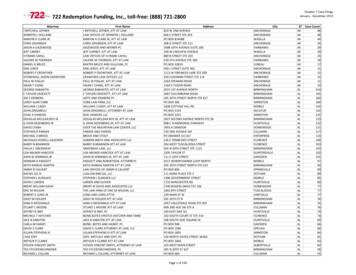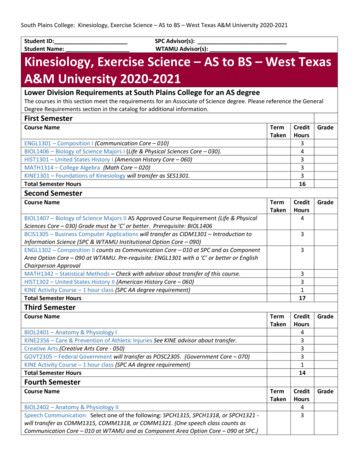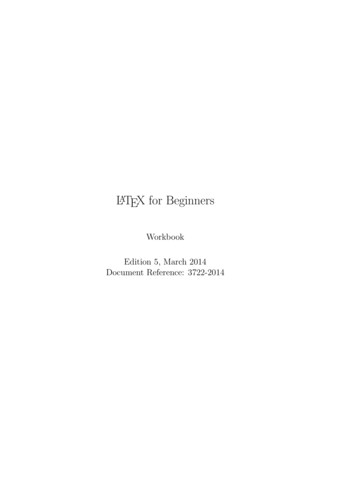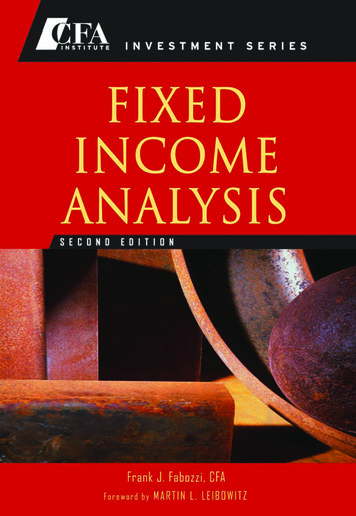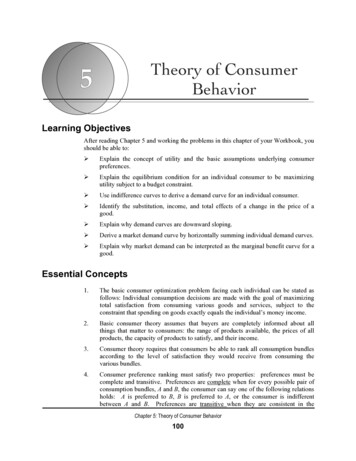
Transcription
Learning ObjectivesAfter reading Chapter 5 and working the problems in this chapter of your Workbook, youshould be able to: Explain the concept of utility and the basic assumptions underlying consumerpreferences. Explain the equilibrium condition for an individual consumer to be maximizingutility subject to a budget constraint. Use indifference curves to derive a demand curve for an individual consumer. Identify the substitution, income, and total effects of a change in the price of agood. Explain why demand curves are downward sloping. Derive a market demand curve by horizontally summing individual demand curves. Explain why market demand can be interpreted as the marginal benefit curve for agood.Essential Concepts1.The basic consumer optimization problem facing each individual can be stated asfollows: Individual consumption decisions are made with the goal of maximizingtotal satisfaction from consuming various goods and services, subject to theconstraint that spending on goods exactly equals the individual’s money income.2.Basic consumer theory assumes that buyers are completely informed about allthings that matter to consumers: the range of products available, the prices of allproducts, the capacity of products to satisfy, and their income.3.Consumer theory requires that consumers be able to rank all consumption bundlesaccording to the level of satisfaction they would receive from consuming thevarious bundles.4.Consumer preference ranking must satisfy two properties: preferences must becomplete and transitive. Preferences are complete when for every possible pair ofconsumption bundles, A and B, the consumer can say one of the following relationsholds: A is preferred to B, B is preferred to A, or the consumer is indifferentbetween A and B. Preferences are transitive when they are consistent in theChapter 5: Theory of Consumer Behavior100
following way: If bundle A is preferred to bundle B, and bundle B is preferred tobundle C, then bundle A must be preferred to bundle C.5.While completeness and transitivity are absolutely necessary assumptions inconsumer theory, it is convenient to add a third assumption (nonsatiation): more ofa good is always preferred to less of a good.6.The benefits consumers obtain from the goods and services they consume is calledutility. A utility function shows an individual's perception of the level of utility thatwould be attained from consuming each conceivable bundle of goods.7.Indifference curves provide a means of depicting graphically the preferences of aconsumer. An indifference curve is a locus of points, representing different bundlesof goods and services, each of which yields the same level of total utility orsatisfaction.8.Indifference curves are negatively sloped and convex. Therefore, if theconsumption of one good is increased, consumption of the other must be reduced tomaintain a constant level of utility. The marginal rate of substitution (MRS)—theabsolute value of the slope of the indifference curve—diminishes as the consumermoves downward along an indifference curve, increasing X and decreasing Y.9.An indifference map consists of several indifference curves. The higher (or furtherto the right) an indifference curve is on the map, the greater the level of utilityassociated with the curve.10.Marginal utility is the addition to total utility that is attributable to the addition ofone unit of a good to the current rate of consumption, holding constant the amountsof all other goods consumed ( MU ΔU ΔX ).11.The marginal rate of substitution shows the rate at which one good can besubstituted for another while keeping utility constant. It can be interpreted as theratio of the marginal utility of X divided by the marginal utility of Y:MRS ΔY MU x ΔX MU ywhere ΔY / ΔX is the negative of the slope of the indifference curve.12.The consumer's budget line shows all possible commodity bundles that can bepurchased at given prices with a fixed amount of money income. The relationbetween money income (M ) and the amount of goods X and Y purchased can beexpressed asM Px X PyYAlternatively, the equation for the budget line can be rewritten in the form of astraight lineY M Px XPy PyThe first term, M/Py , gives the amount of Y the consumer can buy if no X ispurchased. The term Px /Py is the absolute value of the slope of the budget line.Chapter 5: Theory of Consumer Behavior101
13.An increase (decrease) in money income causes a parallel outward (backward) shiftin the budget line. An increase (decrease) in the price of X causes the budget line topivot inward (outward) around the original vertical intercept.14.A consumer maximizes utility subject to a limited money income at thecombination of goods for which the indifference curve is just tangent to the budgetline. At this combination, the marginal rate of substitution (the absolute value ofthe slope of the indifference curve) is equal to the price ratio (the absolute value ofthe slope of the budget line)MRS ΔY MU x Px ΔX MU y PyThus a consumer allocates money income so that the marginal utility per dollarspent on each good is the same for all commodities purchasedMU x MU y PxPyand all income is spent.15.The demand curve of an individual for a specific commodity relates utilitymaximizing quantities purchased to market prices, holding constant money incomeand the prices of all other goods. The slope of the demand curve illustrates the lawof demand: quantity demanded varies inversely with price.16.When the price of a good changes, the total change in quantity demanded can bedecomposed into two parts: (i) the substitution effect, and (ii) the income effect.The substitution effect is the change in consumption of a good after a change in itsprice, when the consumer is forced by a change in money income to consume atsome point on the original indifference curve. Considering the substitution effectonly, the amount of the good consumed must vary inversely with its price. Theincome effect of a price change is the change in the consumption of a goodresulting strictly from the change in purchasing power. The total effect of a pricechange is equal to the sum of the substitution and income effects:Total effect of price change Substitution effect Income effect17.Considering the substitution effect alone, an increase (decrease) in the price of agood causes less (more) of the good to be demanded. For a normal good, theincome effect adds to (or reinforces) the substitution effect. The income effect inthe case of an inferior good offsets (or takes away from) the substitution effect.18.Market demand is a list of prices and the quantities consumers are willing and ableto purchase at each price in the list, other things being held constant. Marketdemand is derived by horizontally summing the demand curves for all theindividuals in the market.19.Because demand prices along market demand measure the economic value of eachunit of the good, a market demand can be interpreted as the marginal benefit curvefor a good.Chapter 5: Theory of Consumer Behavior102
Matching Definitionsbudget linecomplete property of preferencesconsumption bundleGiffen goodincome effectindifference curvesmarginal rate of substitutionmarginal utilitymarket demandsubstitution effecttotal effecttransitive property of preferencesutilityutility function1.The satisfaction or benefit that consumers receive fromconsuming goods or services.2.A particular combination of specific quantities of goodsor services.3.Consumers can rank all conceivable bundles of goods orservices.4.If A is preferred to B, and B is preferred to C, then A isalways preferred to C.5.Equation showing a consumer’s perception of the totalutility forthcoming from consuming each bundle ofgoods and services.6.A set of consumption bundles each and every one ofwhich provides a consumer with exactly the same levelof total utility.7.The number of units of Y that must be given up for totalutility to remain the same when one more unit of X isconsumed.8.The addition to total utility attributable to consumingone more unit of a good, holding the consumption of allother goods constant.9.Line showing all bundles of goods that can be purchasedat given prices if the entire income is spent.10.The change in the consumption of a good that wouldresult if the consumer remained on the originalindifference curve after the price of the good changes.11.The change in consumption of a good resulting strictlyfrom the change in purchasing power after the price of agood changes.12.The sum of the substitution and income effects.13.A good for which quantity demanded varies directlywith price, causing an upward sloping demand curve.14.A list of prices and the corresponding quantityconsumers are willing and able to purchase at each price.Chapter 5: Theory of Consumer Behavior103
Study Problems1.The following figure shows a portion of a consumer’s indifference map. Theconsumer faces the budget line ZL, and the price of Y is 20.a.The consumer's income . The price of X is .b.c.d.e.The equation for the budget line ZL is Y .What combination of X and Y would the consumer choose? Why?The marginal rate of substitution at the combination in part c is .Explain in terms of the MRS why the consumer would not choose eithercombination A or B.If the budget line pivots to ZM, the consumer chooses units of goodX and units of good Y.Along budget line ZM, the price of X is and the price of Y is .The new MRS is equal to .f.g.h.Chapter 5: Theory of Consumer Behavior104
2.The figure below shows a portion of a consumer’s indifference map, and a budgetline. The consumer’s income is 1,200 and the price of Y is 6.a.3.Using the given budget line, what is one point on the consumer’s demand forX?b.Pivot the budget line and derive two other points on the consumer’s demandfor X.Using the consumer's indifference map shown in the figure below, derive the total,substitution, and income effects caused by a decrease in the price of X.Chapter 5: Theory of Consumer Behavior105
4.Suppose the marginal utility of the last unit of X consumed is 40, and the marginalutility of the last unit consumed of Y is 30. The prices of X and Y are 4 and 2,respectively. Should the consumer increase or decrease consumption of X?Explain carefully.5.Suppose there are four consumers in the market for good X. The quantitiesdemanded by each of the four consumers at each price between 1 and 5 areshown in the table below:Quantity Demandeda.b.c.Price d 151283 241072 33861 42630 51410Fill in the blanks in the table for the market quantity demanded at each price.Using the following graph, draw the demand curves for each of the fourconsumers. Label them D1, D2, D3, and D4.Construct the market demand curve in the graph and label it Dmarket demand.Chapter 5: Theory of Consumer Behavior106
6.A consumer is indifferent between 6X and 4Y and 4X and 8Y.a.b.The marginal rate of substitution between these points is equal to .Over this range, the consumer is just willing to give up units of Yto obtain another X.Over this range, the consumer is just willing to give up units of Xto obtain another Y.c.7.The following table shows the marginal utility for each of six units of X and Y. Theprice of X is 4 and the price of Y is 2.a.b.8.QuantityMUXMUY120142161231284561086654If the consumer’s income is 20, the consumer will purchaseunits of good X and units of good Y.If the consumer’s income is 26, the consumer will purchaseunits of good X and units of good Y.Fill in the blanks.a.b.How much of one good a consumer must give up in the market to obtainanother unit of some other good is given by .How much of one good a consumer is just willing to give up to obtainone more unit of another good is given by .Chapter 5: Theory of Consumer Behavior107
Multiple Choice / True-FalseFor questions 1 and 2 use the figure below that shows a consumer's indifference map.1.Which of the following statements is (are) true?a.The consumer is indifferent between bundles A and B.b.The consumer prefers bundle B to C.c.Bundle B is less expensive than bundle A.d.both a and c.e.both a and b.2.The marginal rate of substitution at point Aa.is equal to the absolute value of the slope of the tangent line TT’.b.is smaller than the MRS at point B.c.measures the increase in total satisfaction from consuming one more unit ofX and one less unit of Y.d.is equal to the MRS at point B.3.Which of the following is NOT one of the assumptions for the theory of consumerbehavior?a.Consumers have complete knowledge regarding their money income, theprices of all goods and services, and the capacity of each good to satisfy theconsumer.b.More of a good is preferred to less of a good.c.Consumers can rank order all bundles of goods.d.Indifference curves are concave.Chapter 5: Theory of Consumer Behavior108
Use the following figure to answer Questions 4 – 7. This figure shows two indifferencecurves for a consumer.4.The marginal rate of substitution at point A is .a.1b.2c.3d.4e.55.The marginal rate of substitution between points A and B is .a.1b.2c.1/2d.2/3e.3/26.If the consumer moves from B to A, that consumer is willing to give up X for Y atthe rate X for Y.a.1; 1b.1/2; 1c.3; 2d.2; 1e.1; 27.If utility-maximizing equilibrium is at point A, what could make the consumermove to a point on curve II?a.The price of Y falls.b.The price of X falls.c.Income rises.d.All of the above.e.None of the above.Chapter 5: Theory of Consumer Behavior109
Use the following figure to answer questions 8 – 13. The consumer’s income is 500.Chapter 5: Theory of Consumer Behavior110
8.The price of Y is .a. 1b. 2c. 4d. 5e. 109.The value of P2 is .a. 1b. 5c. 10d. 20e. 2510.The value of X2 is .a.5b
2. Basic consumer theory assumes that buyers are completely informed about all things that matter to consumers: the range of products available, the prices of all products, the capacity of products to satisfy, and their income. 3. Consumer theory requires that consumers be able to
